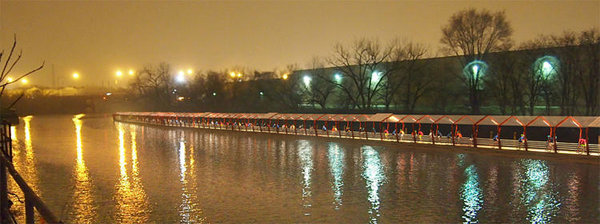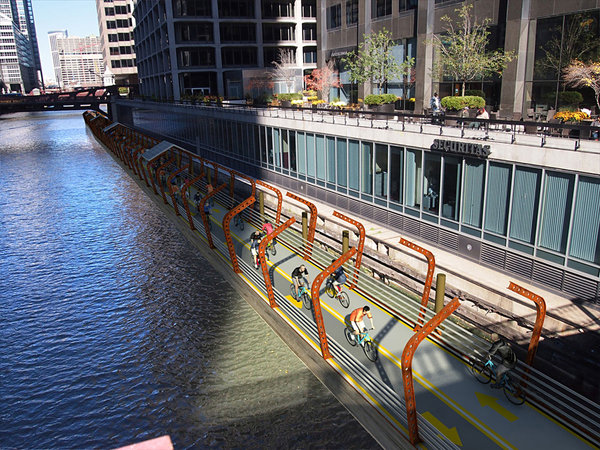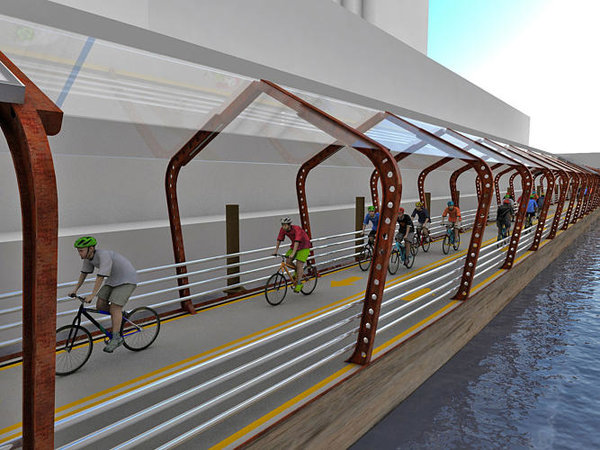It’s getting easier to bike to work in Chicago. The city added 100 miles of new bike lanes over the last five years, and, by 2019, plans to add another 50 miles of “better” bike lanes, including lanes with curbs to protect riders from cars.
Now the city is beginning to consider going further, with a series of floating, solar-powered bike paths along the edge of the Chicago River.

For architecture firm SecondShore, which proposed the idea, it’s partly a way to make better use of the river. “You look at the river, and while it used to be the main commercial artery in the city, it’s not much of one anymore,” says entrepreneur James Chuck, cofounder of SecondShore. “This fits with the mayor’s general economic strategy for the city—how do we make use of latent infrastructure?”
The river also happens to run from densely populated neighborhoods to downtown, alongside some of the busiest streets in the city, where most bike crashes happen. Chuck argues that even separated bike lanes can’t fully protect riders, because those lanes end at each intersection.
“In reality, 55% of crashes and fatalities happen at intersections, and you can’t create a divided lane for bikes at intersections,” he says.
The floating bike paths, called RiverRide, would give people on bikes a truly car-free place to ride for part of their commute, and then connect with existing bike lanes. The system would fill gaps in the network, creating around a 17-mile stretch of continuous bike paths and connecting 28 neighborhoods.
Floating on concrete pontoons—like a similar path in Portland, Oregon—the paths would use solar power for lighting. Solar panels could also heat the surface, so the path doesn’t get icy in the winter, and run retractable awnings that roll out to protect riders if it’s raining or snowing.

At key points, the path would connect with bridges, so people can cross over to the other side of the river.
Of course, all of this wouldn’t be cheap: Each mile of pathway might cost between $5 and $10 million. When architects proposed the Thames Deckway, a floating bike path in London, critics argued that it would make much more sense to invest in better infrastructure on streets. After all, various studies have found that biking gets safer the more cyclists are on a street at the same time.
But Chuck thinks that the floating path could convince many more people to ride—right now, roughly 90% of Chicagoans don’t feel comfortable biking with cars.
“Let’s say 10% of that 90% group decided, ‘Hey, I love RiverRide; I’m willing to go out on my bike right now,'” he says. “We’ve doubled the number of riders in the city.”
He also thinks the city needs to continue to build out better infrastructure on city streets. “This has to integrate into those systems,” he says.
The path, made from steel-reinforced concrete, could also be locally produced.
SecondShore hopes to run a pilot project, perhaps by the summer of 2017, in Chicago’s 33rd Ward, giving riders a chance to experience a half mile of a basic iteration of the path, and giving the designers feedback on the system. The firm is working now to build support for the idea. If all goes well, they would begin installing segments in the spring of 2018. The final path, with 6 to 8 miles of floating pontoons, would connect more than 20 miles of Chicago.
Source: Fast Coexist
Women of Green is TURNING UP THE VOLUME of the feminine voice on the planet in order to create the world we know is possible.
